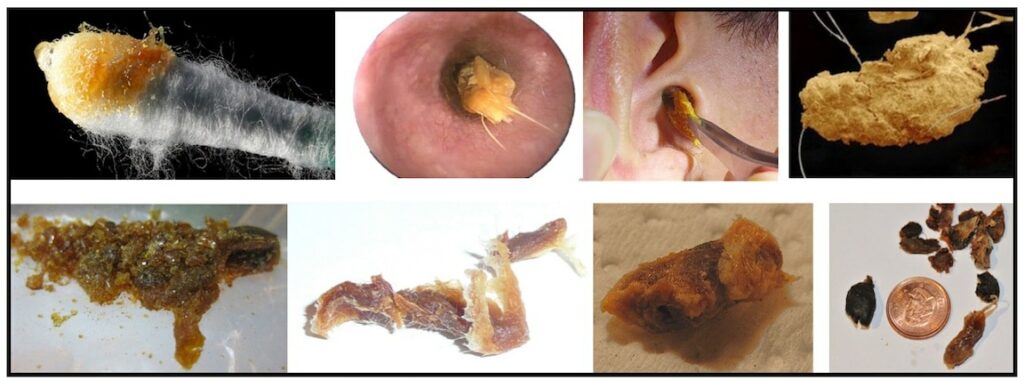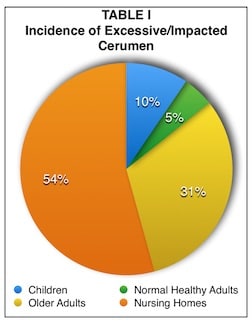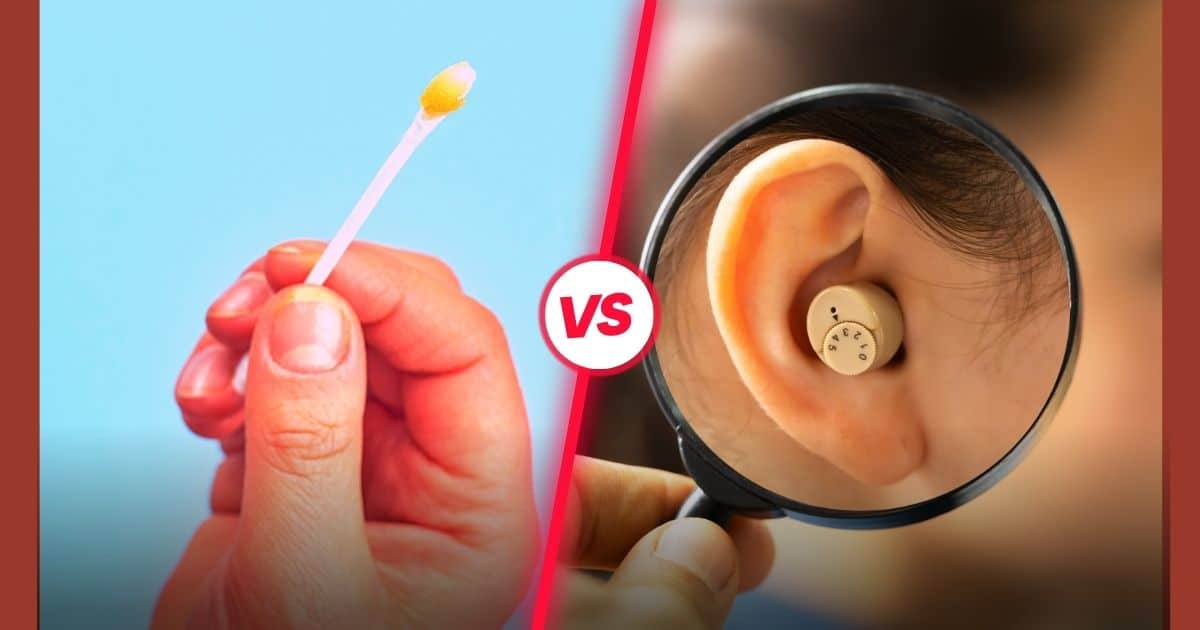For purposes of discussion, it is recognized that earwax (technically, cerumen) in ears is normal. It is a naturally-produced and self-draining viscous substance. However, at times, it can become impacted (hardened) and remains in the ear canal (Figure 1).
Under these conditions, earwax and hearing aids do not go well together. It is impacted earwax that is the primary target of this post and the next week’s post.

Figure 1. Different forms of impacted cerumen (earwax) that has been removed for the ear (all panels except upper left, which shows wet cerumen taken from the ear canal).
Definition of Cerumen Impaction

Figure 2. Impacted cerumen that occludes the entire ear canal. This is in a somewhat “wet” stage.
“Cerumen impaction is defined as an accumulation of cerumen that causes symptoms, prevents a needed assessment of the ear canal/tympanic membrane or audio-vestibular system, or both; and although “impaction” usually implies that cerumen is lodged, wedged, or firmly packed in the ear canal (Figure 2), the definition of cerumen impaction does not require a complete obstruction1.”
Incidence of Earwax Buildup
 Cerumen impaction varies widely. Table I shows that in children it is present in approximately 10%; in about 5% of normal healthy adults; in about 33% in older adults1,2; and in as much as 57% of older patients in nursing homes1. A linear relationship between age and increase of excessive/impacted cerumen was reported by Gleitman, et. al.3.
Cerumen impaction varies widely. Table I shows that in children it is present in approximately 10%; in about 5% of normal healthy adults; in about 33% in older adults1,2; and in as much as 57% of older patients in nursing homes1. A linear relationship between age and increase of excessive/impacted cerumen was reported by Gleitman, et. al.3.
The aging process results in a decrease in the number and activity of ceruminous glands, resulting in a drier type of cerumen. When coupled with an increase in the coarseness of hairs in the ear canal, especially in males, the prevalence of excessive and impacted cerumen increases4. The presence of impacted cerumen has a particular impact in Long Term Facilities (LTF) where it can easily impact on an existing hearing deficit.
Impacted cerumen is reported to lead to 12 million patient visits and 8 million cerumen removal procedures annually in the United States5. It comprises 12.8% of the total ENT consultations in a study in Italy6. Cerumen removal is the most common ENT (ear, nose, and throat) procedure performed in primary care7.
Who Are More at Risk of Cerumen Buildup/Impaction?
The following list is not exclusive, but provides some conditions most vulnerable to impacted cerumen:
- Ear canals not fully formed
- Hairy ear canals
- Narrow ear canals
- History of recurring impacted cerumen
- Those with osteomas (benign, non-cancerous bony growths in the ear canal, often associated with cold water swimming)
- Recurring ear infections
- Certain skin conditions
- The ageing process
- Sharp bends in the ear canal
Earwax Buildup Symptoms
Accumulation of cerumen is usually asymptomatic but can occasionally cause bothersome symptoms, such as hearing loss and ear discomfort. Additional symptoms to the affected ear(s) include, among others:
- Partial hearing loss
- Tinnitus (Ringing in the Ear)
- Earache
- Fullness or stuffiness in the ear
- A sensation that the ear is plugged
- An unpleasant odor
- Persistent cough
Earwax Buildup Causes
Blockage, or impaction, occurs when the wax gets pushed deep into the ear canal.
The key to understanding earwax buildup relates to the location where such blockage occurs. It is known that impacted earwax, while generally found deep in the ear canal, is not where it is produced – that being in the outer cartilaginous ear canal. So, it has to arrive at this position by some means.
It is reasonable to assume that earwax retention will occur whenever there is an obstruction of the ear canal. Over time the natural obstacles provided by a torturous ear canal (double bends in the ear canal), complications related to any ear surgery, and wiry hairs (particularly in males), can lead to obstruction. To these can be added the reported claim that hearing aids can be blamed as well for cerumen impaction8, 9,10,11,12,13.
Reported means to push the earwax more deeply into the ear canal include, but are not limited to:
- Objects inserted into the ear canal to remove earwax. This includes Q-tips14, and other such objects often used to remove earwax (bobby pins, rolled napkin corners, toothpicks, keys, etc.).
- Hearing aids
- Earplugs/earbuds
Hearing Aids and Earwax
There is a common belief among hearing practitioners who fit hearing aids, that repeated insertion of a hearing aid or earmold (the same could hold true for other earbud-type devices), increases cerumen impaction. It is thought that repeated insertion results in wax being pushed back into the ear canal where it accumulates and eventually leads to obstruction15,16.
Interestingly, a recent report found no empirical study to support this assumption17 and as a result, the researchers conducted a study to investigate further. The retrospective study used 164 consecutive hearing aid wearers/patients (255 ears) who were referred to a hospital cerumen clinic in Wales. Cerumen impaction was categorized into four types; Type 1: no cerumen; Type 2: non-occluding cerumen; Type 3: occluding cerumen; and Type 4: fully occluding cerumen and debris.
Results showed no association between hearing aid use and increased cerumen impaction. Also, there was no association between the left and right ears and cerumen impaction. While the authors found the results to be interesting and clinically useful, they suggested further prospective and well-controlled studies to confirm the results.
Next week’s post will continue this discussion about earwax, but will focus primarily on how cerumen affects hearing aid performance.
References
- Clinical practice guideline: cerumen impaction. Roland PS, Smith TL, Schwartz SR, Rosenfeld RM, Ballachanda B, Earll JM, Fayad J, Harlor AD Jr, Hirsch BE, Jones SS, Krouse HJ, Magit A, Nelson C, Stutz DR, Wetmore S. Otolaryngol Head Neck Surg. 2008 Sep;139(3 Suppl 2):S1-S21. 10.1016/j.otohns.2008.06.026.
- Guest JF, Greener MJ, Robinson AC, Smith AF. Impacted cerumen: composition, production, epidemiology and management. QJM 2004; 97:477.
- Gleitman RM, Ballachanda BB, Goldstein DP (1992). Incidence of cerumen impaction in general adult population. Hear J:45:28-32.
- Ruby R . (1986). Conductive hearing loss in the elderly. JOtolaryngol 15:245-247.
- Mitka M. Cerumen removal guidelines wax practical. JAMA 2008; 300:1506.
- Earwax, clinical practice, Beatrice, S. Bucolo, R. Cavallo ENT Department, San Giovanni Bosco Hospital, ASL TO2, Turin; Prevention Department S.Pre.S.A.L., ASL TO5, Chieri (TO), Italy.
- Jabor MA, Amedee RG. Cerumen impaction. J La State Med Soc 1997; 149:358.
- Browing GC. Updated ENT. 2nd ed. London: Butterworth, 1987.
- Katz J. Handbook of clinical audiology. Baltimore: Williams and Wilkins Co, 1972.
- https://my.clevelandclinic.org/services/head-neck/diseases-conditions/hic-cerumen-impaction-earwax-buildup-and-blockage.
- https://www.healthline.com/health/earwax-buildup#Overview1
- https://www.audicus.com/five-things-you-never-knew-about-earwax/
- https://www.murine.com/en/Tips.html
- https://hearinghealthmatters.org/hearinginternational/2014/q-tip-controversy/
- Meador JA. Cerumen impaction in the elderly. J Gerontol Nurs 1995;21:43–45.
- Lewis-Cullinan C, Janken JK. Effect of cerumen removal on the hearing ability of geriatric patients. J Adv Nurs. 1990;15:594–600.
- Manchaiah V, Arthur J, Williams H. Does hearing aid use increase the likelihood of cerumen impaction? J Audiol Otol. 2015 Dec; 19(3): 168–171.
Wayne Staab, PhD, is an internationally recognized authority in hearing aids. As President of Dr. Wayne J. Staab and Associates, he is engaged in consulting, research, development, manufacturing, education, and marketing projects related to hearing. His professional career has included University teaching, hearing clinic work, hearing aid company management and sales, and extensive work with engineering in developing and bringing new technology and products to the discipline of hearing. This varied background allows him to couple manufacturing and business with the science of acoustics to bring innovative developments and insights to our discipline. Dr. Staab has authored numerous books, chapters, and articles related to hearing aids and their fitting, and is an internationally-requested presenter. He is a past President and past Executive Director of the American Auditory Society and a retired Fellow of the International Collegium of Rehabilitative Audiology.
**this piece has been updated for clarity. It originally published on May 10, 2016







lets for a moment consider this observation:
Earwax generally forms in the middle of the first bend in the ear canal. Therefore, the target zone is the aperture till the middle of the first bend. Under normal conditions, the keratinous tissue migrates from the umbo on the TM outwards, and keeps moving laterally until it meets with the earwax at the middle of the first bend, where it is neutralized by the chemicals in the wax and rolls up into tiny pellets that drop off naturally into the concha bowl. one can even remove this “ball”, with the nails from the beginning of the first bend. The hearing aid, in most cases will push this development back towards the second bend and an accumulation may take place just before the isthmus. You may see some earwax on the tips of the hearing aids, and even around it in the canal portion. Impaction takes place almost always after the end of the first bend, where some narrowing causes accumulation. That study is flawed. Note that RIC aids do not push back on the earwax, and instead it helps in leaving a fine film of earwax in the middle of the first bend. The wax takes almost a year to harden in dry canals. In healthy ears this time may increase to two years.
Wayne, great observational write ups ! Many thanks.
Jay Muhury.
Yes, that is in the outer 1/3 of the ear canal. It is not possible for wax to form more deeply than that. You might be thinking of where we usually find it after it has been pushed in slightly. And that is certainly true.